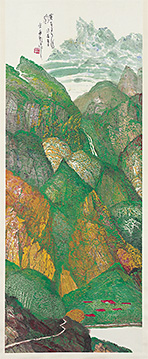Special Exhibitions
Warriors, Beasts, and Spirits: Early Chinese Art from the James Conley Collection June 11–August 28, 2011 Baumgartner and Schroeder Gallerias
Warriors, Beasts, and Spirits features more than forty ancient Chinese tomb artifacts, including carvings, ceramic sculptures, and architectural fragments, lent from the private collection of James Conley. This large collection offers an unprecedented, comprehensive view of the artistic development of Chinese art from the Han, Tang, and Ming dynasties, three of the most compelling periods of China’s early history. These objects are admired today for their intrinsic beauty as works of art, as well as for their historical and religious significance. Nearly two thousand years old, the artworks reflect astonishing artistic and technological sophistication.
The exhibition presents a parade of mythical beasts, guardian spirits, large-scale horses, entertainers, and an extraordinary assembly of bronze and ceramic vessels. The imaginative creatures of the supernatural world were created to provide protection against evil spirits in the afterlife. Tomb artifacts also included reproductions of objects used during one’s lifetime for use in the next world as well, where the activities of domestic life were thought to continue.
James Conley has spent more than forty years collecting early Chinese art and has assembled an exceptional collection of this material. Having grown up in Wisconsin, Conley, who today is founder and CEO of Conley Publishing, attended art classes at the Milwaukee Art Museum as a child.
Emerald Mountains: Modern Chinese Ink Paintings from the Chu-tsing Li Collection June 11–August 28, 2011 Koss Gallery
Drawn from the Chu-tsing Li collection of modern Chinese paintings, Emerald Mountains explores how mid-twentieth-century Chinese artists maintained a deep engagement with traditional Chinese ink painting, while simultaneously creating work that reflected their own political and cultural environments, as well as new developments in the international art world. The collection is the finest and most comprehensive of its kind in the West. Many of the works in the exhibition are shanshui (mountain and water) paintings, a style of Chinese painting that depicts natural landscapes and usually includes mountains, rivers, and waterfalls. A centuries-old tradition, shanshui paintings are not rigorous copies of the landscape but rather representations of the artists’ thoughts and feelings about nature. Mountains often play a significant role in shanshui painting because of their sacred status in Chinese culture. These extraordinary paintings demonstrate the reinvigoration of classical techniques and materials by artists working with distinctly contemporary perspectives throughout Mainland China and the East.
Born in Mainland China and a resident of the United States since 1947, Chu-tsing Li was one of the first scholars of traditional Chinese painting to take a serious look at contemporary Chinese work. To further his own understanding, he engaged with Chinese artists in their studios—a radical undertaking for a scholar of classical art in the 1960s—and encouraged them to investigate their own tradition as they learned from Western influences.
On Site: Zhan Wang June 11–September 11, 2011 Windhover Hall
For the past decade, China has become increasingly important in the global art scene, to the extent that Beijing is now mentioned along with New York, London, and Berlin as a locus of contemporary art. Sculptor Zhan Wang is among the most important artists in this burgeoning scene.
Born in 1962, the Beijing-based artist is best known for his stunning Scholar Rock series. For centuries, traditional Chinese scholar rocks were placed in private gardens to serve as miniature representations of mountains, which in turn signified the whole of nature, or “Tao.” Scholars and collectors selected rocks for contemplation based on their complexity and inherent beauty. Two fine examples are included in The Emperor’s Private Paradise: Treasures from the Forbidden City exhibition.
Zhan Wang updates the scholar rock tradition. Rather than selecting rocks from nature for private meditation, he painstakingly creates these forms from highly polished stainless steel, as with Artificial Rock No. 43, for public display. These works are reflective, industrial, and powerful—mirroring China in the twenty-first century.
Way of the Dragon: The Chinoiserie Style, 1710–1830 June 30–November 06, 2011 Decorative Arts Gallery
Chinoiserie is a style of ornamentation that developed in the seventeenth and eighteenth centuries out of a growing interest in the exotic, admiration for the beauty of Asian art, and a curiosity about Chinese people and places. The Museum has partnered with the Chipstone Foundation to present more than fifty decorative objects from their collections and the collections of local private lenders to explore the numerous ways in which China was viewed at the time. Way of the Dragon serves as a counterpoint to Treasures from the Forbidden City, for Britain’s chinoiserie objects were not so much a literal interpretation of Chinese artistic tradition as an expression of Western ideas about the East.
Travel narratives initially informed the chinoiserie style, but as more wares from China, including porcelain and textiles, were imported into Great Britain, artisans could reference authentic Asian examples for their patterns. Over time, however, the Chinese motifs found on chinoiserie objects became increasingly fantastic and diverse. Rather than copies of Chinese porcelain or interpretations of the East, these pieces had developed their own aesthetic that often said more about British culture. Why this shift to fantasy took place and what these representations tell us about Britain’s understanding of itself, Asia, and the objects they both produced are questions Way of the Dragon seeks to address.

![Figure: Screen [detail]](media/image/art/conley_warrior_148.jpg)

![Figure: Screen [detail]](media/image/art/onsite_01_148.jpg)
![Figure: Screen [detail]](media/image/art/chipstone_teapot.jpg)








